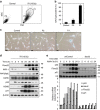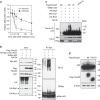SCF(Fbxo22)-KDM4A targets methylated p53 for degradation and regulates senescence
- PMID: 26868148
- PMCID: PMC4754341
- DOI: 10.1038/ncomms10574
SCF(Fbxo22)-KDM4A targets methylated p53 for degradation and regulates senescence
Abstract
Recent evidence has revealed that senescence induction requires fine-tuned activation of p53, however, mechanisms underlying the regulation of p53 activity during senescence have not as yet been clearly established. We demonstrate here that SCF(Fbxo22)-KDM4A is a senescence-associated E3 ligase targeting methylated p53 for degradation. We find that Fbxo22 is highly expressed in senescent cells in a p53-dependent manner, and that SCF(Fbxo22) ubiquitylated p53 and formed a complex with a lysine demethylase, KDM4A. Ectopic expression of a catalytic mutant of KDM4A stabilizes p53 and enhances p53 interaction with PHF20 in the presence of Fbxo22. SCF(Fbxo22)-KDM4A is required for the induction of p16 and senescence-associated secretory phenotypes during the late phase of senescence. Fbxo22(-/-) mice are almost half the size of Fbxo22(+/-) mice owing to the accumulation of p53. These results indicate that SCF(Fbxo22)-KDM4A is an E3 ubiquitin ligase that targets methylated p53 and regulates key senescent processes.
Figures








Similar articles
-
SCFFBXO22 targets HDM2 for degradation and modulates breast cancer cell invasion and metastasis.Proc Natl Acad Sci U S A. 2019 Jun 11;116(24):11754-11763. doi: 10.1073/pnas.1820990116. Epub 2019 May 28. Proc Natl Acad Sci U S A. 2019. PMID: 31138683 Free PMC article.
-
SCF(FBXO22) regulates histone H3 lysine 9 and 36 methylation levels by targeting histone demethylase KDM4A for ubiquitin-mediated proteasomal degradation.Mol Cell Biol. 2011 Sep;31(18):3687-99. doi: 10.1128/MCB.05746-11. Epub 2011 Jul 18. Mol Cell Biol. 2011. PMID: 21768309 Free PMC article.
-
FBXO22, an epigenetic multiplayer coordinating senescence, hormone signaling, and metastasis.Cancer Sci. 2020 Aug;111(8):2718-2725. doi: 10.1111/cas.14534. Epub 2020 Jul 17. Cancer Sci. 2020. PMID: 32536008 Free PMC article. Review.
-
Fbxo22-mediated KDM4B degradation determines selective estrogen receptor modulator activity in breast cancer.J Clin Invest. 2018 Dec 3;128(12):5603-5619. doi: 10.1172/JCI121679. Epub 2018 Nov 12. J Clin Invest. 2018. PMID: 30418174 Free PMC article.
-
Emerging role of FBXO22 in carcinogenesis.Cell Death Discov. 2020 Jul 27;6:66. doi: 10.1038/s41420-020-00303-0. eCollection 2020. Cell Death Discov. 2020. PMID: 32793396 Free PMC article. Review.
Cited by
-
Blocking PD-L1-PD-1 improves senescence surveillance and ageing phenotypes.Nature. 2022 Nov;611(7935):358-364. doi: 10.1038/s41586-022-05388-4. Epub 2022 Nov 2. Nature. 2022. PMID: 36323784
-
Jumonji C Demethylases in Cellular Senescence.Genes (Basel). 2019 Jan 9;10(1):33. doi: 10.3390/genes10010033. Genes (Basel). 2019. PMID: 30634491 Free PMC article. Review.
-
SCFFBXO22 targets HDM2 for degradation and modulates breast cancer cell invasion and metastasis.Proc Natl Acad Sci U S A. 2019 Jun 11;116(24):11754-11763. doi: 10.1073/pnas.1820990116. Epub 2019 May 28. Proc Natl Acad Sci U S A. 2019. PMID: 31138683 Free PMC article.
-
Small molecule KDM4s inhibitors as anti-cancer agents.J Enzyme Inhib Med Chem. 2018 Dec;33(1):777-793. doi: 10.1080/14756366.2018.1455676. J Enzyme Inhib Med Chem. 2018. PMID: 29651880 Free PMC article.
-
Histone lysine demethylase 4 family proteins maintain the transcriptional program and adrenergic cellular state of MYCN-amplified neuroblastoma.Cell Rep Med. 2024 Mar 19;5(3):101468. doi: 10.1016/j.xcrm.2024.101468. Cell Rep Med. 2024. PMID: 38508144 Free PMC article.
References
-
- Smith J. R. & Pereira-Smith O. M. Replicative senescence: implications for in vivo aging and tumor suppression. Science 273, 63–67 (1996). - PubMed
-
- Blackburn E. H. Switching and signaling at the telomere. Cell 106, 661–673 (2001). - PubMed
-
- Shay J. W. & Wright W. E. Aging. When do telomeres matter? Science 291, 839–840 (2001). - PubMed
-
- Johmura Y. et al.. Necessary and sufficient role for a mitosis skip in senescence induction. Mol. Cell 55, 73–84 (2014). - PubMed
MeSH terms
Substances
LinkOut - more resources
Full Text Sources
Other Literature Sources
Molecular Biology Databases
Research Materials
Miscellaneous

